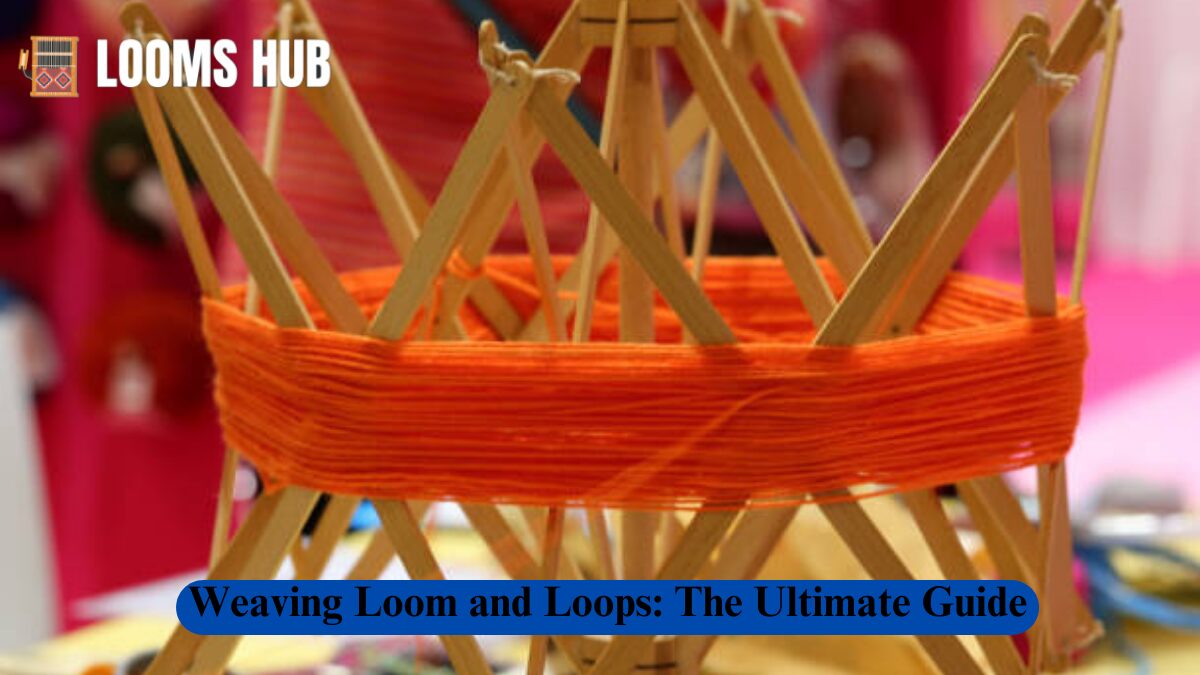Weaving loom and loops has been an integral part of human history for centuries, intertwining artistry, skill, and utility. Whether you’re a seasoned weaver or a curious beginner, understanding weaving looms and loops is key to mastering the craft. This comprehensive guide will delve into the essentials of weaving, different types of looms, and the beauty of loops in creating intricate designs.
What is weaving?
Weaving is the process of interlacing threads to create fabric. It relies on two key components:
- Warp threads: longitudinal threads that are held taut.
- Weft threads: threads woven over and under the warp threads.
The technique allows for a wide range of textures, patterns, and fabric types, from lightweight silks to heavy woolen blankets.
The Historical Significance of Weaving
Weaving dates back thousands of years and has evolved alongside civilizations. Early weavers used natural materials like grasses and animal hair to craft simple textiles. Over time, looms were developed to increase efficiency and enable intricate patterns. The art of weaving became a cornerstone of cultural expression, with techniques and styles passed down through generations. In regions like Peru, India, and Africa, traditional weaving methods still thrive today, preserving a rich legacy.
- Example: The backstrap loom, widely used in Central and South America, is a portable tool that enables weavers to create intricate designs while maintaining a deep connection to their heritage.
- Fun Fact: The oldest known woven textile, discovered in Turkey, dates back to around 7000 BCE, showcasing humanity’s early ingenuity.
Types of Weaving Looms
Looms are essential tools for weaving. They hold the warp threads under tension, allowing you to interlace the weft threads efficiently. Let’s explore the various types of looms and their applications:
Frame Looms
Description: Simple and portable, frame looms are ideal for beginners and small projects like wall hangings or coasters.
- Advantages:
- Affordable and easy to use.
- Requires minimal setup.
- Limitations:
- Limited to smaller projects.
- Manual tensioning of warp threads.
Frame looms often serve as the first step for beginners, enabling them to learn basic weaving techniques before progressing to more complex tools. Their portability makes them a favorite for hobbyists looking to weave on the go.
Rigid Heddle Looms
Description: Versatile and compact, these looms include a heddle that simplifies weaving.
- Advantages:
- Faster weaving process.
- Suitable for scarves, placemats, and other medium-sized projects.
- Features:
- Built-in heddle for thread separation.
- Adjustable tension for consistency.
Rigid heddle looms strike a balance between simplicity and versatility. They are perfect for those ready to explore new patterns and textures, making them an excellent choice for intermediate weavers.
Floor Looms
Description: These large, sturdy looms are perfect for advanced weavers creating larger textiles.
- Advantages:
- Allows for complex patterns.
- Offers a large working area.
- Limitations:
- Expensive and requires dedicated space.
Floor looms are the powerhouse of weaving. They provide a robust structure for crafting large pieces like blankets, rugs, and upholstery fabrics. With multiple shafts, they allow for intricate designs that are impossible on simpler looms.
Table Looms
Description: Compact and efficient, table looms are excellent for intermediate projects and portability.
- Key Features:
- Multiple shafts for intricate designs.
- Manual operation for controlled weaving.
Table looms offer a middle ground between rigid heddle looms and floor looms. They’re ideal for those who want to experiment with patterns without investing in a floor loom.
| Loom Type | Ideal For | Pros | Cons |
| Frame Loom | Beginners, small projects | Affordable, portable | Limited size, manual setup |
| Rigid Heddle | Medium-sized projects | Easy to use, versatile | Limited complexity |
| Floor Loom | Advanced, large projects | Complex patterns, sturdy | Expensive, space-intensive |
| Table Loom | Intermediate, detailed designs | Compact, portable | Slower than floor looms |
The Art of Loops in Weaving
Loops add texture, dimension, and character to woven fabrics. Incorporating loops can transform a plain textile into a work of art.
How to Create Loops
- Manual Looping: Use your fingers or a crochet hook to pull weft threads into loops.
- Using a Rya Knot: A traditional knot technique ideal for creating loops in rugs or wall hangings.
- Tension Adjustment: Maintain even tension to ensure uniform loops.
Applications of Loops
- Decorative Wall Hangings: Add depth and texture to artistic pieces.
- Rugs and Mats: Use durable materials like wool to create thick loops for comfort.
- Accessories: Incorporate loops into scarves or bags for a playful touch.
Loops not only serve as a decorative element but also enhance the functionality of textiles. For instance, looped rugs offer a soft, cushioned surface, while looped scarves add a layer of warmth and texture.
Weaving Materials: Choosing the Right Yarn
Your choice of yarn significantly affects your weaving project’s outcome. Consider these factors:
Types of Yarn
- Natural Fibers:
- Cotton: lightweight and breathable, ideal for summer projects.
- Wool: Warm and stretchy, great for winter textiles.
- Silk: luxurious and smooth, perfect for high-end creations.
- Synthetic Fibers:
- Acrylic: Budget-friendly and versatile.
- Nylon: durable and resistant to wear.
Yarn Thickness
- Thin Yarns: suitable for fine, delicate fabrics.
- Thick Yarns: perfect for bold textures and quick projects.
| Yarn Type | Best For | Characteristics |
| Cotton | Lightweight projects | Breathable, soft |
| Wool | Warm clothing, rugs | Stretchy, insulating |
| Silk | Luxury textiles | Smooth, shiny |
| Acrylic | Budget-friendly items | Durable, versatile |
| Nylon | Heavy-use fabrics | Resistant to wear and tear |
Tips for Beginners Exploring Weaving Loom and Loops
Starting your weaving journey can feel overwhelming, but these tips will set you on the right path:
- Start Small: Begin with a frame loom and simple projects.
- Practice Tension Control: Ensure your warp threads are evenly tensioned.
- Experiment with Patterns: Try basic techniques like plain weave and twill.
- Join a Community: Engage with online forums or local weaving groups for support.
- Invest in Quality Tools: High-quality looms and yarns make a significant difference in your results.
“Weaving is not just about creating fabric; it’s about weaving your story into every thread.”
Advanced Techniques for Weaving Loom and Loops Experts
For those looking to take their skills to the next level, advanced techniques can open up a world of creative possibilities.
Double Weave
Create two layers of fabric simultaneously, which can be joined or remain separate. This technique is perfect for blankets and reversible textiles.
Tapestry Weaving
Incorporate intricate designs and imagery using discontinuous weft threads. Tapestry weaving allows for artistic expression, making each piece unique.
Leno Weave
A technique where warp threads are twisted to create open, lacy patterns. This is commonly used in lightweight, airy fabrics.
FAQs
What is the best type of loom for beginners?
A frame loom is often the best choice for beginners. It is affordable, easy to use, and great for small projects like coasters or wall hangings.
How do I maintain even tension while weaving loom?
To maintain even tension:
- Ensure warp threads are stretched tautly.
- Use tools like tensioning bars or weighted objects.
- Adjust tension regularly as you weave.
Can I use any type of yarn for weaving loom?
Not all yarns are suitable for weaving. Natural fibers like cotton and wool are excellent choices for most projects, while synthetic fibers like acrylic can be used for durability. Always choose yarn based on your project’s requirements.
What is the purpose of loops in weaving?
Loops add texture, depth, and dimension to woven pieces. They are often used in decorative projects like wall hangings, rugs, and accessories.
How do I create patterns on a loom?
Patterns can be created by:
- Using different colors for the warp and weft threads.
- Employing advanced techniques like twill or tapestry weaving.
- Incorporating additional tools like heddles for more intricate designs.
How long does it take to complete a weaving project?
The time required depends on:
- The size and complexity of the project.
- Your experience level.
- The type of loom being used. Small projects might take a few hours, while larger ones can take several weeks.
Conclusion
Weaving loom and loops offer endless possibilities for creativity and craftsmanship. Whether you’re making a vibrant wall hanging or a cozy blanket, understanding the tools, techniques, and materials is essential to achieving stunning results. So pick up your loom, gather your yarn, and start weaving your masterpiece today!



